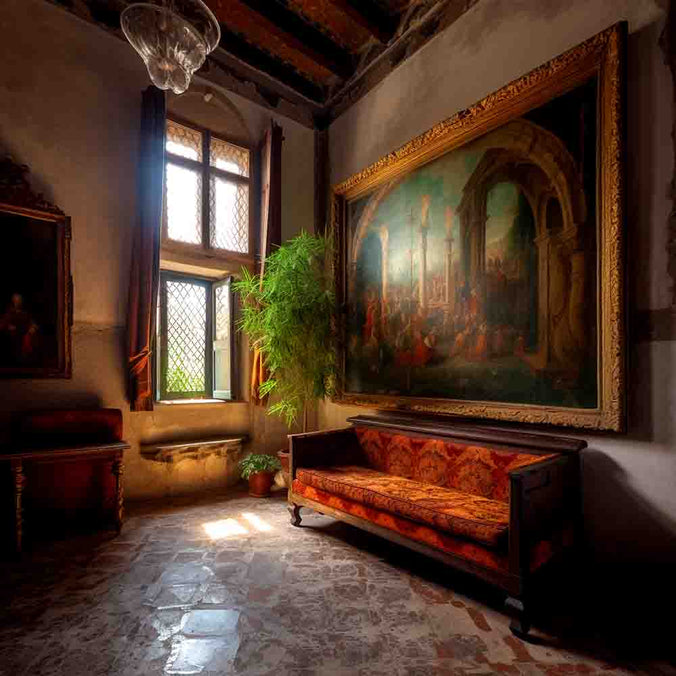What is Impressionism as an Art?

What is Impressionism as an Art?
Impressionism is a 19th-century art movement characterized by its focus on capturing light, color, and movement in the natural world through loose brushstrokes and vibrant colors. Key artists include Claude Monet, Edgar Degas, Pierre-Auguste Renoir, and Camille Pissarro. Impressionism's influence can be seen in various art forms, including abstract art, digital art, photography, and even fashion. Aspiring painters can learn valuable lessons from Impressionism, such as embracing spontaneity, capturing the essence of a scene, and experimenting with color and light. Impressionism continues to inspire contemporary artists, who utilize modern technology to create Impressionist-inspired works, demonstrating the movement's lasting impact on the art world.
Characteristics of Impressionism
Impressionist paintings are recognized by their loose brushstrokes, vibrant colors, and emphasis on capturing the changing light and atmosphere of a scene. The artists often applied colors without mixing them, creating a lively surface that appears to shimmer with light.
Landscapes and scenes of everyday life were common subjects for Impressionist painters. Some of the most influential artists of this movement include Claude Monet, Edgar Degas, Pierre-Auguste Renoir, Frederic Bazille, Paul Cezanne, and Mary Cassatt.
The influence of Impressionism can also be found in music, with composers such as Claude Debussy, Maurice Ravel, and Erik Satie often associated with the movement.
Claude Monet's Impression Sunrise
Impression Sunrise, painted in 1872 by Claude Monet, is considered the quintessential Impressionist painting. This work features a scene of Le Havre, Normandy, with the sun rising above the water. Monet used visible brushstrokes and a vivid color palette to convey the atmosphere and the fleeting effects of light on the water's surface.
Famous Impressionist Artists
Impressionism attracted many talented artists who sought to capture the essence of their subjects using this unique style.
Some of the most notable Impressionist painters include:
- Claude Monet, known for his series of paintings of water lilies, haystacks, and the Rouen Cathedral.
- Edgar Degas, famous for his depictions of ballet dancers, horse racing, and urban scenes.
- Camille Pissarro, who often portrayed rural life and worked extensively with landscapes.
- Pierre-Auguste Renoir, celebrated for his vibrant scenes of people enjoying life and leisure activities.
Painting in the Impressionist Style
If you are interested in painting in the Impressionist style, keep these key principles in mind:
- Focus on capturing light and atmosphere.
- Use loose, rapid brushstrokes.
- Apply colors without mixing them, allowing the viewer's eye to blend them optically.
- Emphasize contrast between warm and cool colors.
- Keep the composition simple and avoid excessive detail.
Abstract Art: From Impressionism to Modernism
Abstract art, which emerged in the early 20th century, marked a departure from the representation of the physical world. Artists like Wassily Kandinsky, who was inspired by the Impressionists' focus on color and light, sought to express emotions and ideas through non-representational forms and shapes.
Modern abstract art encompasses a wide variety of styles and media, from geometric shapes to large-scale installations. The influence of Impressionism can be seen in the work of abstract artists who continue to emphasize color, light, and the emotional impact of their art.
Incorporating Abstract Art into Your Home Décor
Abstract art can add a unique and dynamic touch to your home décor. When selecting abstract art for your space, consider these tips:

- Choose a piece that reflects your personal style and complements the existing décor.
- Consider the size of the artwork and the available space on your walls.
- Use abstract art to create a focal point or as part of a theme in your room.
- Pair complementary pieces or series to create a cohesive display.
By understanding the roots of Impressionism and its influence on modern abstract art, you can appreciate the evolution of artistic expression and its impact on our visual culture. As you incorporate abstract art into your home décor, you'll be able to create a dynamic and visually appealing space that reflects your personal taste and the rich history of art movements that have shaped our understanding of beauty and creativity.
The Enduring Legacy of Impressionism
The Impressionist movement has left a lasting impact on the world of art, paving the way for new styles and artistic expressions. Even today, more than a century after the movement began, Impressionism continues to inspire and captivate art enthusiasts and collectors. Its influence can be seen in various art forms, including photography, digital art, and even fashion.
Learning from Impressionist Techniques
Artists and aspiring painters can learn a great deal from the techniques employed by the Impressionists. By studying their methods and understanding the principles that guided their work, you can enhance your own artistic skills and develop a unique style.
Some lessons to take from Impressionism include:
- Embracing spontaneity and trusting your instincts.
- Capturing the essence of a scene, rather than focusing on the minute details.
- Experimenting with color and light to create a desired mood or atmosphere.
- Being open to new techniques and materials, as well as learning from the work of other artists.
Impressionism in the Digital Age
In the digital age, Impressionism remains relevant as artists and designers continue to draw inspiration from the movement's innovative techniques and emphasis on color and light. Digital art and photography have made it easier than ever to capture the fleeting effects of light and atmosphere that Impressionist painters sought to convey.
Through photo manipulation, digital painting, and other digital art forms, contemporary artists can create Impressionist-inspired works that maintain the spirit of the movement while pushing the boundaries of what is possible with modern technology.
Impressionism has left an indelible mark on the world of art, influencing generations of artists and shaping the course of modern artistic expression. As you explore the legacy of Impressionism, from its impact on abstract art to its continued relevance in the digital age, you'll gain a deeper appreciation for this groundbreaking movement and the artists who brought it to life. By incorporating Impressionist-inspired art into your home décor and learning from the techniques and principles that guided the movement, you can celebrate the enduring beauty and innovation of Impressionism in your everyday life.
Leave A Reply
Your email address will not be published. Required fields are marked *






